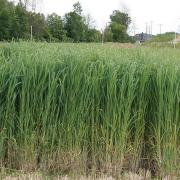There are several benefits to using grasses, such as switchgrass and miscanthus, as biofuel feedstocks. They grow on marginal lands, prevent soil erosion better than row crops, and require fewer inputs. Read below about the advantages and drawbacks of grass crops.
 |
| Farmers use traditional farm equipment to grow and harvest switchgrass. Photo: Dennis Pennington, Bioenergy Educator, Michigan State University. |
Contents
Introduction to Grasses as Biofuel Feedstocks
Grasses are a family of monocotyledonous plants that includes species both familiar and vital to our society. Corn, rice, wheat, barley, sorghum, oats and rye are some of the more common grain examples. Apart from their contribution as food crops, in recent years, an increasing emphasis has been placed on their potential use as a major source of energy.
While corn has been the most notable example, the use of the term “grasses” when speaking of biofuel foodstocks generally refers to members of the family that are not grown for food production, but rather as a livestock feed or for conservation purposes. Although still a controversial subject, government agencies and private enterprises have begun investing large amounts of money in the research and development of these non-food producing grass crops in the hopes of finding an efficient means of extracting energy for a range of fuels.
Benefits of Grass Production for Energy
There are a number of benefits to be gained from using grasses as bioenergy crops, including decreased demand on food crops for energy production, soil conservation, improved water use efficiency, reduced amendments of nitrogen fertilizer, fewer input costs, carbon sequestration,
 |
| Mature stand of switchgrass in its third year of production at Michigan State University. Photo: Dennis Pennington, Bioenergy Educator, Michigan State University. |
wildlife benefits and increased utilization of marginal lands.
Grasses such as switchgrass and miscanthus are warm season perennials which utilize the C4 pathway to fix CO2 and more efficiently use water during respiration. This allows the plants to tolerate the drier conditions experienced during drought or in areas of highly drained, sandy soils.
These grasses are also very efficient users of nutrients and require much less intensive management than typical annual grasses like corn. Switchgrass generally requires less nitrogen than a Midwest corn crop and, if harvested after dessication in the fall, it will translocate nutrients from the above-ground biomass to its roots. With proper management during the harvest, farmers can capitalize on this process and leave these stored nutrients in the ground to be used in the following crop cycle. This has the beneficial effects of reducing fertilizer input, improving profitability and increasing the environmental sustainability of the crop.
Perennial crops also save farmers money and input costs because they don’t need to be planted every year. Although there is a balance to be found between lower production perennials and higher production annuals, annuals tend to demand more time and to have higher overhead cost requirements for the farmer. Due to less frequent plantings, perennials offer an opportunity to reduce labor costs and other associated inputs. However, presently, prices of raising some of these crops will not pay for the cost of establishment and production in many areas. Harvest, storage and transportation are major issues that will need to be considered to make these crops economically feasible.
Grass crops offer yet another advantage: the ability to be grown on marginal lands that are less productive and not conducive to conventional agronomic crop production. The reduced demand on prime agricultural land has the effect of reducing competition between food and fuel crops. Yields will be lower on marginal lands, but with low input costs, grass crops provide another option for land that would otherwise not be producing a crop.
For Additional Information
- Lee Rinehart, Switchgrass as a Bioenergy Crop. ATTRA National Sustainable Agriculture Information Service, 2006.
- Feedstocks for Biofuel Production
- Switchgrass for Biofuel Production
- Miscanthus for Biofuel Production
Grass Feedstocks in the News
- Biofuel Economics: Will Pure Switchgrass Stands Be Required for Cellulosic Ethanol?
Contributors to This Article
Authors
- Andrew Moss, University of Maryland
- Dennis Pennington, Bioenergy Educator, Michigan State University
Peer Reviewers
- Zane Helsel, Extension Specialist in Agricultural Energy, Rutgers University
- Don Day, Extension Associate in Energy, University of Missouri
